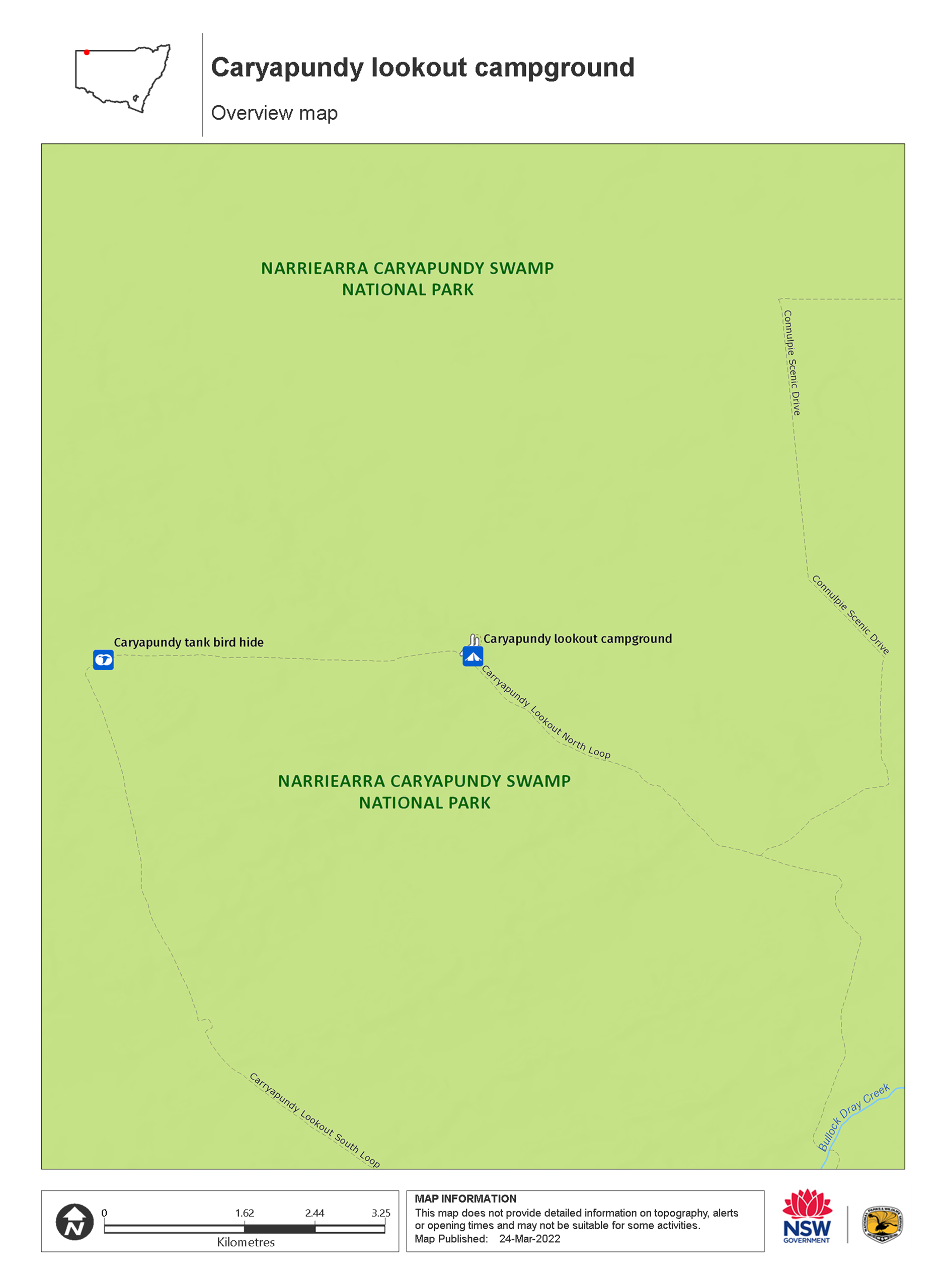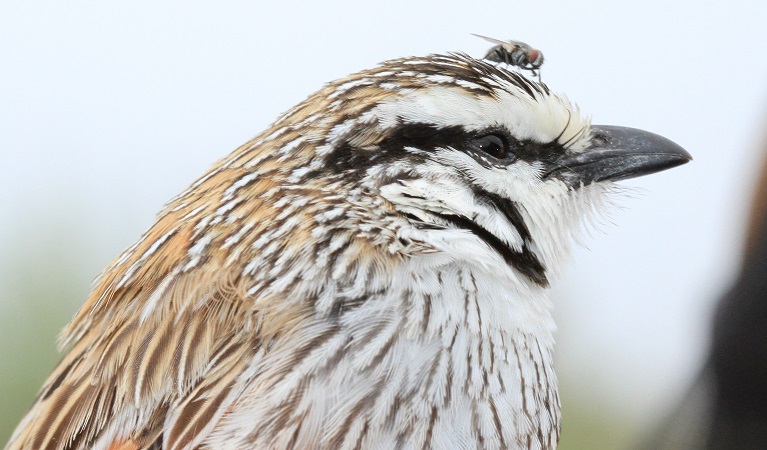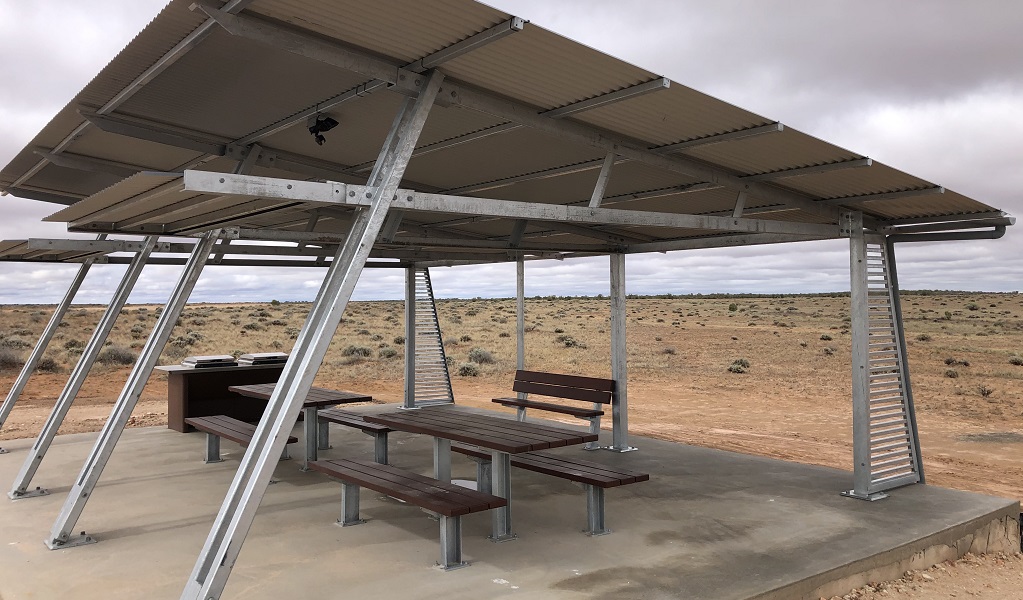Caryapundy lookout campground
Narriearra Caryapundy Swamp National Park
Overview
If you enjoy remote, self-sufficient camping in outback NSW, Caryapundy lookout campground is for you. Located east of Tibooburra, it has an incredible view, picnic area and a night sky perfect for stargazing.
| Number of campsites | 18 |
|---|---|
| Camping type | Tent, Camper trailer site, Caravan site, Camping beside my vehicle |
| Facilities | Picnic tables, barbecue facilities, carpark, toilets |
| What to bring | Drinking water, cooking water, torch, food supplies, first aid kit, personal locator beacon, insect repellent, sunscreen |
| Entry fees | Park entry fees apply |
| Group bookings | Book up to 20 people or 5 sites online. For larger groups, make a group booking enquiry. |
| Please note |
|
When it floods, areas of this massive national park transform from semi-arid plains into huge lakes and swamps that are havens for rare waterbirds. At Caryapundy lookout campground, located on a small escarpment above Caryapundy Swamp, you’ll have the park’s best view of this spectacle. Even when the swamp is dry, you’ll still enjoy an impressive outlook over sweeping plains stretching as far as the eye can see.
Once you’ve set up camp, start photographing the views from Caryapundy lookout. Or take a short walk down to the swamp's edge to study its unique ecosystem up close. Birdwatchers, see if you can spot a brown falcon soaring above, or a stubble quail hiding in a bluebush.
Explore the park on the Caryapundy lookout loop drive, and when night falls have fun spotlighting around the campground with your torch. You might see a spotted nightjar flying across the escarpment. Or simply relax and enjoy some stargazing.
Autumn and spring are the best times of year to visit, when temperatures are cooler, because there’s no shade to set your tent or caravan under at this campground.
Map

Map legend

Local alerts
For the latest updates on fires, closures and other alerts in this area, see https://www.nationalparks.nsw.gov.au/camping-and-accommodation/campgrounds/caryapundy-lookout-campground/local-alerts
Bookings
- National Parks Contact Centre
- 7am to 7pm daily
- 1300 072 757 (13000 PARKS) for the cost of a local call within Australia excluding mobiles
- parks.info@environment.nsw.gov.au
Operated by
- Tibooburra Visitor Centre
- Tibooburra Visitor Centre is always open but it's unstaffed (self service)
- 08 8091 3308
- npws.westdarling@environment.nsw.gov.au
- 51 Briscoe Street, Tibooburra NSW 2880
Park info
- in Narriearra Caryapundy Swamp National Park in the Outback NSW region
- Narriearra Caryapundy Swamp National Park is always open but may have to close at times due to poor weather, road closures or fire danger.
Visitor info
All the practical information you need to know about Caryapundy lookout campground.
Maps and downloads
Learn more
Caryapundy lookout campground is in Narriearra Caryapundy Swamp National Park. Here are just some of the reasons why this park is special:
Home to over 500 species

Although at first glance the outback may look like a barren landscape, you’ll find that this isn’t the case in Narriearra Caryapundy Swamp National Park. Numerous endangered and threatened species live here, and some are found nowhere else in NSW. From the scurrying bearded dragon to a soaring wedge-tailed eagle, there are around 540 species recorded in the park (not including plant species). You may even be lucky enough to spot the endangered grey grasswren (pictured) flitting through the lignum surrounding Bartons tank bird hide.
- Caryapundy lookout loop drive If you’re staying in Tibooburra and only have time for a day drive, try this return drive through Narriearra. Bring a picnic and set out on your journey through this extraordinary outback national park.
- Caryapundy tank bird hide If you’re a keen birdwatcher, don’t miss a visit to Caryapundy tank bird hide in Narriearra Caryapundy Swamp National Park, near Tibooburra. It’s a great place to see some amazing bird species.
The drovers' hotel

Whittabrinnah Hotel was once a bustling place where drovers stopped by on their way through the Adelaide Gate to the markets at Broken Hill and Adelaide. The hotel stood for around 25 years until it burnt down in the early 1890s, and was never rebuilt. You can still see the remaining stone material from the hotel’s buildings, hearths and foundations, and the stockyard across the road. There’s also galvanised iron material amongst a scatter of glass bottles and ceramic jars from daily life at the hotel. The heritage values of these objects are defined by the connection they have with the Whittabrinnah Hotel, so please don’t remove them from this location.
- Caryapundy lookout loop drive If you’re staying in Tibooburra and only have time for a day drive, try this return drive through Narriearra. Bring a picnic and set out on your journey through this extraordinary outback national park.
- Whittabrinnah heritage walk Step back in time when you do this short walk in Narriearra Carapundy Swamp National Park, near Tibooburra. It's an easy stroll around the Whittabrinnah Hotel ruins and great for all ages.
Plants and animals protected in this park
Animals
-

Grey grasswren (Amytornis barbatus barbatus)
The endangered grey grasswren (Bulloo subspecies) lives in the semi-arid floodplains of far western NSW and Queensland. Around 90 percent of this rare bird's NSW habitat is protected within Narriearra Caryapundy Swamp National Park.
-

Australian pelican (Pelecanus conspicillatus)
The curious pelican is Australia’s largest flying bird and has the longest bill of any bird in the world. These Australian birds are found throughout Australian waterways and the pelican uses its throat pouch to trawl for fish. Pelicans breed all year round, congregating in large colonies on secluded beaches and islands.
-

Emu (Dromaius novaehollandiae)
The largest of Australian birds, the emu stands up to 2m high and is the second largest bird in the world, after the ostrich. Emus live in pairs or family groups. The male emu incubates and rears the young, which will stay with the adult emus for up to 2 years.
-

Red kangaroo (Macropus rufus)
The red kangaroo is one of the most iconic Australian animals and the largest marsupial in the world. Large males have reddish fur and can reach a height of 2m, while females are considerably smaller and have blue-grey fur. Red kangaroos are herbivores and mainly eat grass.
-

Short-beaked echidna (Tachyglossus aculeatus)
One of only 2 egg-laying mammals in the world, the short-beaked echidna is one of the most widespread of Australian native animals. Covered in spines, or quills, they’re equipped with a keen sense of smell and a tube-like snout which they use to break apart termite mounds in search of ants.
-

Wedge-tailed eagle (Aquila audax)
With a wingspan of up to 2.5m, the wedge-tailed eagle is Australia’s largest bird of prey. These Australian animals are found in woodlands across NSW, and have the ability to soar to heights of over 2km. If you’re bird watching, look out for the distinctive diamond-shaped tail of the eagle.
Plants
-

Mulga (Acacia aneura)
Mulga are hardy Australian native plants found throughout inland Australia. With an unusually long tap root, the mulga is able to withstand long periods of drought.
-

River red gum (Eucalpytus camaldulensis)
Australian native plants, majestic river red gum trees are widespread across Australian inland river systems. The river red gum is a dominant tree species of the Murray-Darling basin which spans NSW, Queensland and Victoria. This iconic native eucalypt grows to a height of 30m and is thought to have a lifespan up to 500-1000 years.
-

Saltbush (Atriplex nummularia)
A hardy Australian native plant, the saltbush is a small spreading shrub that can withstand dry salty soils such as those found in the desert plains of western NSW. It is grey-white in colour and has small spear-shaped succulent leaves. It flowers from December to April.

